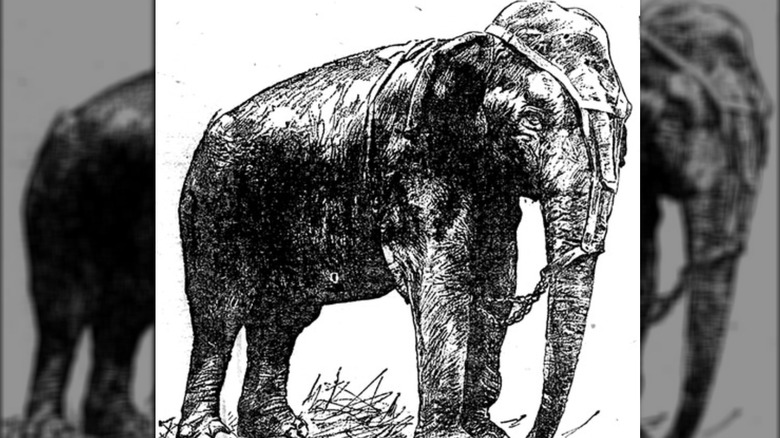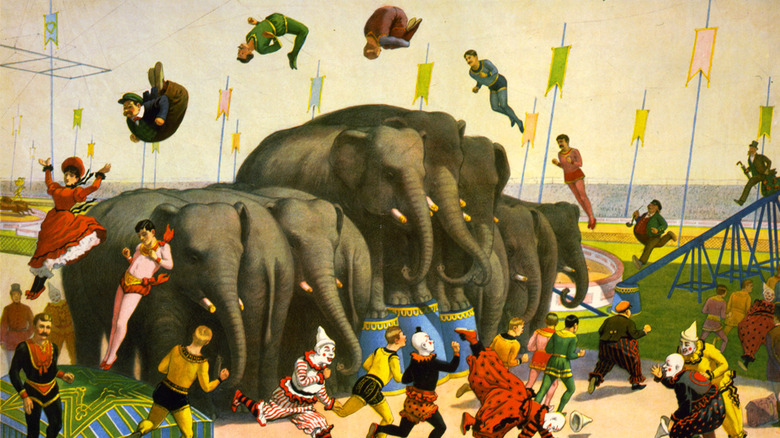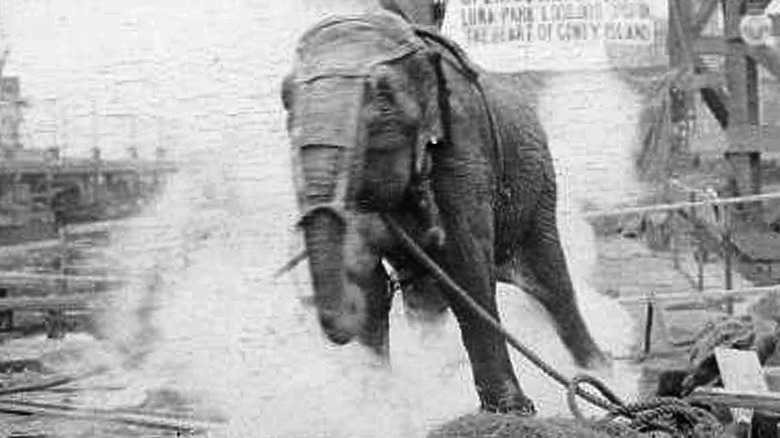The Tragic Story Of Topsy The Elephant
Throughout the 19th and 20th century, hundreds, perhaps thousands, of animals from Africa and Asia were brought to Europe and the United States to be treated as biological curiosities in zoos and circuses. Often, when these animals would react accordingly to abuse or surprise, they would be punished by their captors, and sometimes executed.
Elephants are some of the most common victims of execution by humans because their sheer size made it very easy for them to severely harm or kill people. An Asian elephant named Mary was given the nickname "Murderous Mary" (per Blue Ridge Country) after killing an inexperienced keeper. Mary was executed in 1916. An African elephant from Mozambique, named Tyke, was shot and killed by police in 1994 after killing her trainer, injuring her groomer, and escaping into the streets of Honolulu (per All That's Interesting).
What makes Topsy's execution significant is that she's the only elephant (so far) to be electrocuted to death. The Edison Manufacturing movie company also filmed the execution and released the film under the name "Electrocuting an Elephant" (it's posted on YouTube), which may be one of the first ever animal snuff films.
Topsy's life
Although Topsy was advertised as being "the first elephant born on American soil," she was actually born in Southeast Asia around 1875. But at just a few years old, in 1877, Topsy was kidnapped and smuggled into the United States by Carl Hagenbeck and purchased by American circus owner Adam Forepaugh, writes the Maryland Center for History and Culture in a review of the book "Topsy: The Startling Story of the Crooked-Tailed Elephant, P.T. Barnum, and the American Wizard, Thomas Edison." Forepaugh tried to maintain the ruse that Topsy was born in the United States, but his rivalry with P.T. Barnum led Barnum to publicly accuse Forepaugh of fraud, according to the Brooklyn Daily Eagle.
For almost two decades, Topsy performed as part of the Forepaugh Circus. During that time, she was trained to do tricks with "crowbar beatings, red-hot pokers, and jabs of the bullhook and pitchfork," writes the Maryland Center. Sometimes, she was just beaten out of frustration. During one incident, Forepaugh beat Topsy so viciously that her tail remained crooked afterwards.
It was during her time as part of the Forepaugh Circus that Topsy started getting a reputation for being a "bad" elephant. However, she was doing little more than simply acting like an elephant in captivity. This "troublemaking" reputation was actually more the attendant's fault than Topsy's. Circus owners would often fire "competent, more expensive trainers" when attendance was down and instead hired incompetent trainers who were more easily found. As a result, the elephant was often blamed for the mistakes or abuses of the trainers.
A 'bad' reputation
Topsy made national news in June 1902 when she crushed spectator James Fielding Blount to death against the ground after he burned the trip of Topsy's trunk with a cigar. According to the History Collection, Topsy had reportedly refused to drink the whiskey Blount offered her and he'd gotten angry and burned her trunk as a result. Maryland Center for History and Culture writes that Blount instead did a "bait and switch" on Topsy with the whiskey and the lit cigar and wasn't maliciously burning her, but either way, Blount had no business burning Topsy with the cigar.
Forepaugh continued to display Topsy, this time as the "killer elephant," but (per author Samuel Hawley) there were more nearly fatal incidents with her handlers, who were reportedly frequently drunk, than Forepaugh would've liked them to be. As a result, Topsy was sold to Coney Island's Luna Park, where she continued to suffer abuse, at one point ending up with streaming blood from her "face and flanks," writes All That's Interesting. Although her trainer was arrested for the abuse, the Brooklyn Eagle reported the incident as "Topsy, The Bad Elephant, Makes Trouble At Coney." According to an article posted at Rutgers School of Arts and Sciences, Topsy's trainers also often goaded her into "menac[ing] the local police and some workmen."
It's unclear how many people Topsy ended up killing, because her story was often sensationalized, but it's possible (per Find a Grave) that she killed two more people at Luna Park. What's known for sure is that in 1903, Luna Park arranged for Topsy's execution.
Topsy's execution
For the price of 25 cents, visitors at Luna Park could witness the public execution of Topsy the elephant. Rutgers writes that the managers of Luna Park initially wanted to hang Topsy, but the Society for the Prevention of Cruelty to Animals (SPCA) claimed that hanging was "unnecessarily cruel" and instead approved electrocution. The SPCA didn't end up stopping the hanging of Mary a few years later in 1916 — another elephant that was publicly executed (per All That's Interesting).
Smithsonian magazine writes that "because nobody had ever electrocuted an elephant before," whoever was in charge also decided to make sure she'd be poisoned and strangled as well. For the electrocution, Topsy's legs were put in conductive copper sandals; for the poisoning, she was fed carrots laced with potassium cyanide; a rope was put around her neck for the strangulation.
Although Thomas Edison is often associated with the electrocution, "it's unlikely that Edison was a direct part of Topsy's execution," says Smithsonian. But because the event involved direct current electricity, the Edison Manufacturing movie company was there to film the event.
On January 4, 1903, Topsy was fed the carrots and electrocuted. It took less than 10 seconds for Topsy to die from the electrical current. It's unclear exactly how many people witnessed Topsy's execution, but the estimates range from thousands to "only persons immediately concerned and reporters." The SPCA officers present reportedly said that "they had never seen a more humane manner of causing death."



